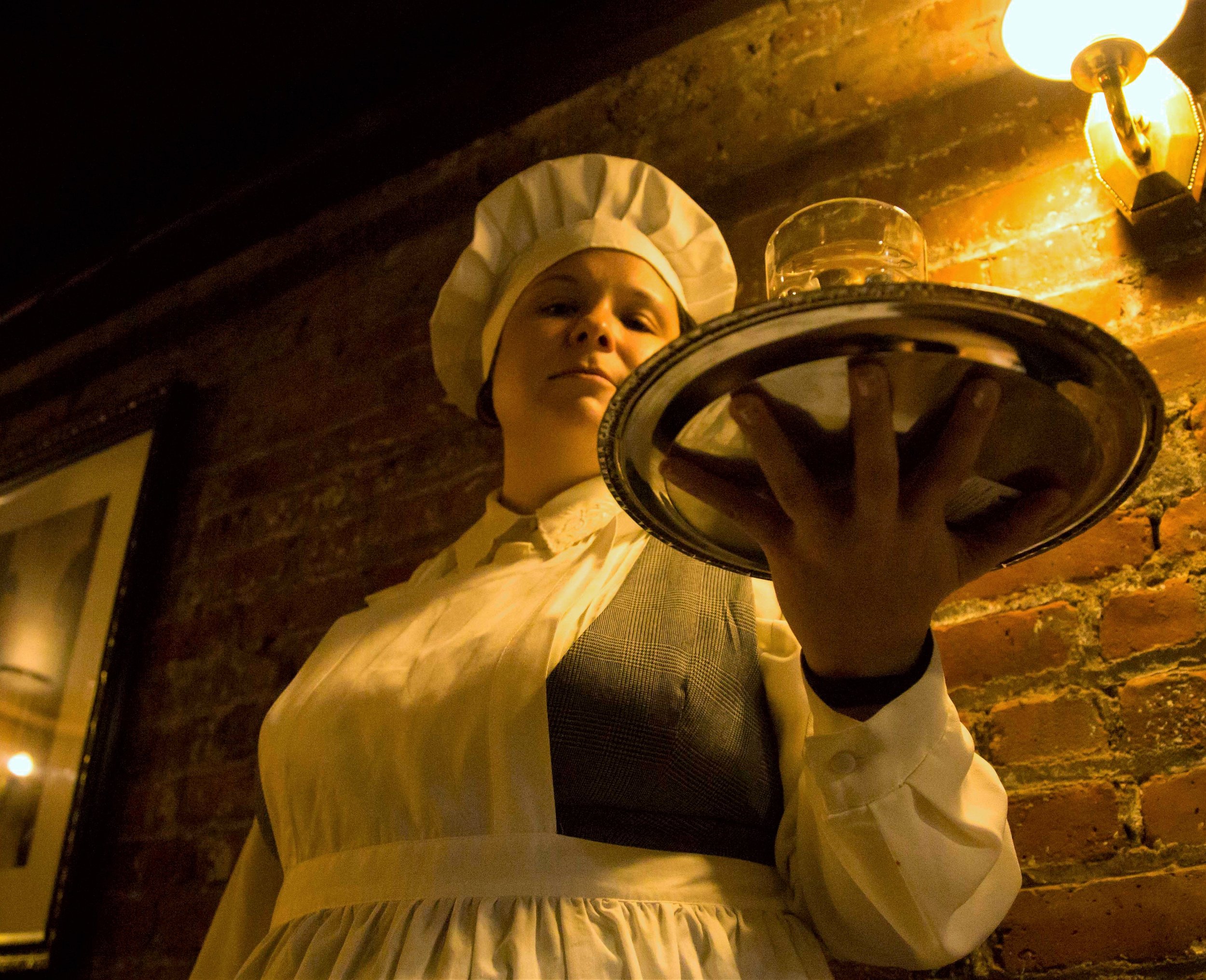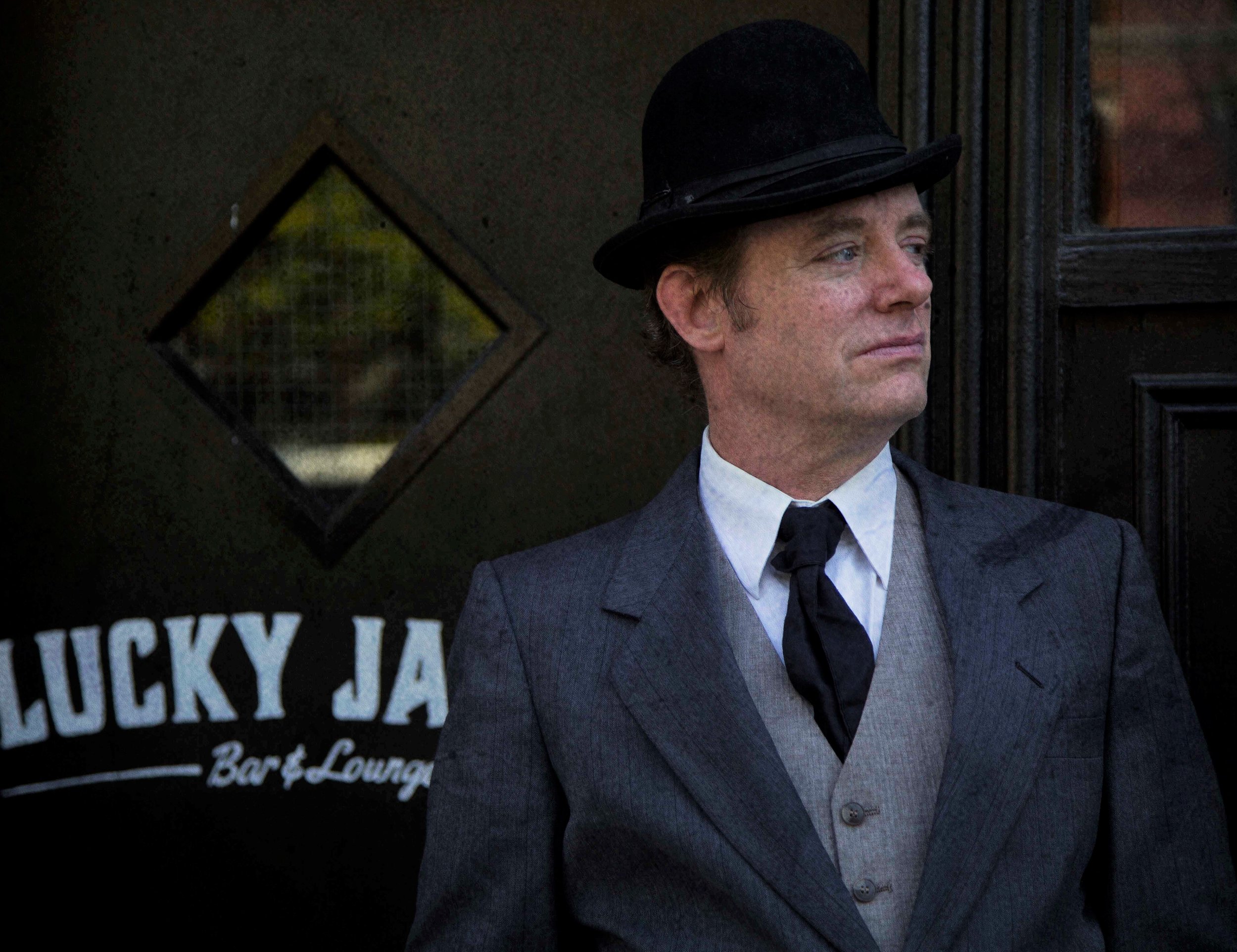Since 2009, Live In Theater has reimagined the murder mystery genre by staging historic events within various nontraditional theatre spaces throughout New York City. The group specializes in interactive, true crime stories, putting some audience members at the center of the action. In The Trial of Typhoid Mary 1915, viewers are faced with the case of Mary Mallon, a domestic cook for affluent New York families during the early 1900s. As a silent carrier of the contagious bacteria that causes typhoid fever, Mallon infected more than 50 New Yorkers, resulting in at least three deaths. However, while Mallon was certainly not the only carrier of the disease, her status as an immigrant woman may have disadvantaged her in the justice system. It is up to the audience to decide whether Typhoid Mary should remain in quarantine for the rest of her natural life or be set free.
Collin Blackard as the defense attorney in The Trial of Typhoid Mary 1915. Top: Erin Bump as the accused, Mary Mallon.
Upon entering the basement of Lucky Jack’s pub on the Lower East Side, audience members are offered a piece of “peach Melba” by a young Irish woman in a cook’s hat (Erin Bump). Of course, this woman’s identity is soon revealed to be Typhoid Mary herself, whose famous fresh peach ice cream historically gave typhus to many of her employers, their families and guests. Hysteria ensues as the authorities anticipate another outbreak of typhoid thanks to Mallon. Audience members have one hour before the trial to determine whether Mallon deserves to be locked up in quarantine or set free. They are given the task of interviewing a cast of characters, including a friend of Mallon; a doctor specializing in emergent germ theory; an Italian baker who is also a silent carrier of the bacteria; and the judge and lawyers of her pending trial.
Live In Theater’s format is simple: set up a conflict, allow the audience to investigate freely, and finally come to a resolution. One reason this format works well is that it encourages a true sense of play (yes, even among grown-ups!). While some interactive theater performances put audience members on the spot, Live In’s intimate set-up facilitates fun one-on-one interactions. While the bravest participants may find themselves in a more active role (such as legal counsel to the defense lawyer), it does feel like one can participate as much or as little as desired.
The likable ensemble of The Trial of Typhoid Mary 1915 embraces the interactive format of the show, with each character improvising a good deal of their own dialogue. In the one-on-one interactions, it becomes clear that the cast has done their research on the events and people in Mary Mallon’s life. Presiding over the trial is Judge S.S. Goldwater (JR McCarthy), whose booming voice and on-the-spot wit keeps the show moving along. Lawyers Francis O’Neill (Collin Blackard) and Prescot Sinclair (Tom Staggs) especially shine as they deftly (and often very comically) incorporate different audience members into the trial.
Of course, lots of variables come into play when bringing random audience members into the spotlight, but the experienced cast handles them with aplomb. One strange and somewhat distracting choice, however, is the incorporation of audience cue cards that instruct the audience to chant things such as “Lock Her Up!,” “Set Her Free,” and “Oh Snap!” It seems like these cards are meant to demonstrate the sensationalized nature of Mallon’s 1915 trial, but, as a staging device, it feels a bit anachronistic within the historical world of the play.
Top: Tom Staggs as the prosecutor. Photos by Natalia Yandyganova
While this interactive show is entertaining overall, one element of the plot lacks development. Considering her repeated negligence, it is unclear why one should feel sorry for Mallon in The Trial of Typhoid Mary 1915. She undoubtedly faced adversity as a woman and as an immigrant, like all other women and immigrants of the time, but it is also true that she refused to wash her hands before handling food and willfully ignored the advice of doctors advising her to have surgery. If there is more complexity behind Mallon’s choices (a religious mistrust of science, perhaps) or her unfair treatment by authorities, the production should frame that conflict more clearly. From a modern perspective, however, Mallon’s disregard for science seems unfathomable; this production could do more to help the audience understand a wider historical context, such as turn-of-the-last-century ignorance about hygiene and disease.
All in all, however, Live In Theater’s Trial of Typhoid Mary 1915 is an enjoyable and unique way to spend a Saturday afternoon in New York City. Creator Carlo d’Amore and director Collin Blackard’s format of interaction is simple yet engaging, immersing participants in a game-like experience of solving a mystery or crime. The interaction of historical characters with modern-day audience members is a recipe for comedy. Live In’s format is especially fun for groups of friends, since one never does know which person in the crew will be cast as part of the action!
Upcoming performances of The Trial of Typhoid Mary 1915 are on Nov. 18 and Dec. 2 at 2 p.m. at Lucky Jack’s (129 Orchard St, on the Lower East Side). Tickets for this show, and for a rotating variety of other murder mysteries from Live In Theater’s repertoire, including the Drama Desk–nominated The Ryan Case 1873, are $59 and may be purchased by visiting liveintheater.com/tickets/.




